#Ruminantia
Explore tagged Tumblr posts
Text
Taxonomy Tournament: Mammals


Ruminantia. This suborder of even-toed ungulates gets nutrients from plant material by fermenting it in a specialised stomach. It includes cattle, yak, deer, sheep, goats, giraffes, and antelopes.
Whippomorpha. This suborder of even-toed ungulates have for the most part lost their toes, becoming dolphins and whales. It also includes hippos.
#animals#biology#polls#poll tournament#zoology#cows#deer#sheep#goats#giraffes#mammals#tetrapods#hippos#dolphins#whales#Ruminantia#Whippomorpha#0x5fv0xa0#animal tournament#Animal Tournament Round 1
141 notes
·
View notes
Text
Deer of up North
There's lots of deer and I can't keep them straight, so here's a list of all deer species found in the subtemperate regions of the Northern hemisphere: Canada, northern Europe, Siberia. This list does not cover the many other deer species.
General deer facts
Deer are ruminants: even-toed ungulates that chew their cud. Yes, that means all true deer are kosher. They're all herbivorous (which means they'll eat meat only if they don't have to work hard for it). True deer are the family Cervidae, but some other species are called "deer" based on looks.
In almost all species, males grow and shed antlers once a year, and females lack antlers. Males also tend to be much larger than females.
Depending on species and region, a male deer is called a stag, buck, or bull; a female deer a doe, hind, or cow; a young deer a fawn or a calf. In French, the male is called the generic term for deer, un cerf; the female is une biche and the young un faon.
Deer are smaller than you expect, except moose, which are bigger. Most deer species have shoulder heights between 50 cm and 1 m. Deer on this list are on the larger side because they live in cold areas.
Most deer are polygynous, with one mating season (rut) per year. Males fight with their antlers over groups of females. Pregnancy is long, and most species have one fawn at a time.
There are 12 species of deer in the area I'm talking about. 11 are true deer, 1 is an impostor amogus.
Red deer (Cervus elaphus)
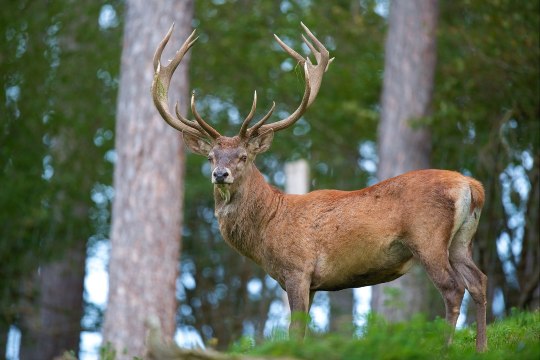
Stag red deer in a forest near Rochefort, Belgium. Photo by Luc Viatour, 2011.
Name in English: Red deer. Name in French: Usually just cerf since it's the default European deer. Cerf élaphe if you're pedantic. Lives in: Europe and Western Asia. Introduced in Australia, New Zealand, and South America. Shoulder height: 1–1.3 m. Red deer are very big as deer go.
This deer is common in Europe, and often hunted and portrayed in art. It's rather social and forms herds. It lives in woods, and migrates to higher altitudes in summer.
Wapiti (Cervus canadensis)
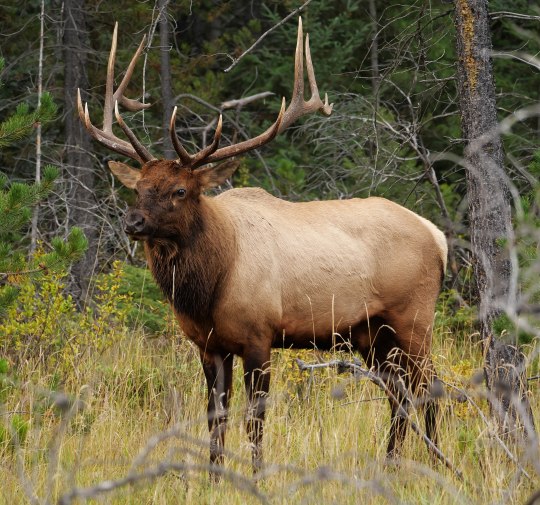
Bull wapiti in Jasper National Park, Alberta, Canada. Photo by Membeth, 2019.
Name in English: In Europe, wapiti. In North America, elk. Ambiguity warning: in Europe, elk usually means moose (Alces alces). Name in French: Exactly the same problem, with the cognate terms. In Europe, wapiti. In North America, élan. Ambiguity warning: in Europe, élan usually means moose (Alces alces). Lives in: North America and East Asia. Introduced to South America and New Zealand. Shoulder height: 0.8–1.5 m. They're even bigger than red deer on average.
The wapiti is closely related to the red deer, and occupies a similar niche. Their native ranges don't overlap, but they often hybridise where both species are introduced.
Sika deer (Cervus nippon)
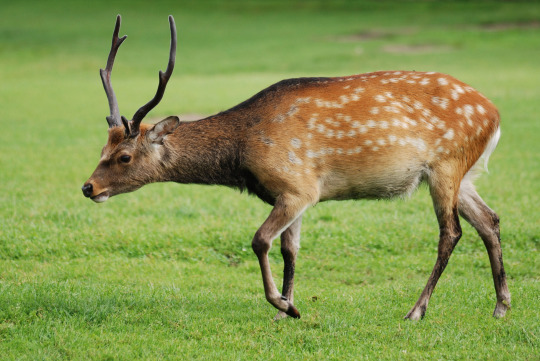
Stag sika deer in Poland. Photo by Lilly M, 2007.
Name in English: Northern spotted deer, Japanese deer, sika deer. Name in French: Cerf sika. Lives in: East Asia, mainly Japan. Introduced to a whole bunch of countries, including Canada, the United States, Russia, and many European countries. Shoulder height: 0.5–1.1 m depending on sex and subspecies.
The sika deer remains spotted as an adult, whereas in most species, only fawns have spots. Its distribution is weird af: its native range is a big chunk of East Asia, but it's died out in most of it, except in Japan where it's breeding like crazy, and it has introduced breeding populations in random places. It's closely related to the red deer and they sometimes hybridise.
Fallow deer (Dama dama)
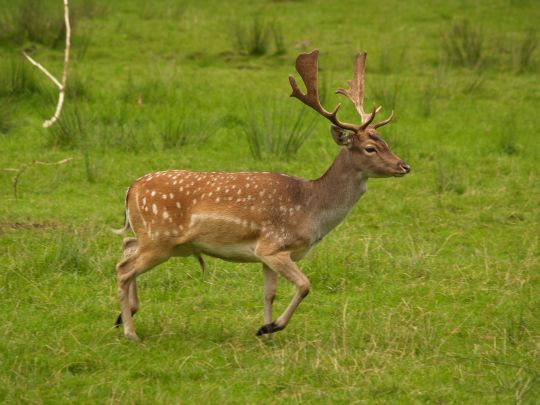
Buck fallow deer in a field in the German state of Schleswig-Holstein. Photo by Johann-Nikolaus Andreae, 2008.
Name in English: Usually simply fallow deer. European or common fallow deer to clarify. Name in French: Daim. To clarify, daim européen. Lives in: Native to Turkey. Introduced in most of Europe, North and South America, parts of Africa, Oceania. Shoulder height: About 85 cm.
Another deer that stays spotted as an adult, though there are many colour variants. It too has a weird distribution. Its antlers have a broad, flat shape.
Reeves's muntjac (Muntiacus reevesi)
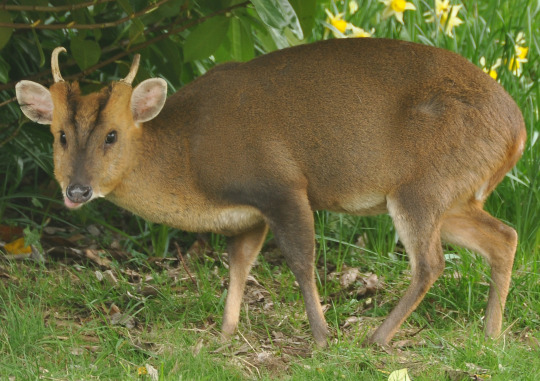
Buck Reeves's muntjac in a garden in England. Photo by Nilfanion, 2010.
Name in English: Reeves's muntjac, Chinese muntjac, barking deer. Sometimes spelt muntjak. Name in French: Lots of different names, none of which are commonly used: muntjac de Reeves, muntjac de Chine, cerf aboyeur, cerf muntjac. Lives in: Native to Taiwan and southeastern China. Introduced in Europe and Japan. Shoulder height: About 50 cm.
There are many species of muntjacs, but only one has established breeding populations far enough north to make this list. All of them are small for deer and breed year-round instead of seasonally.
Bucks of all muntjac species have both tusks and antlers. The tusks are the main weapon; the antlers are short and mostly used to knock opponents out of balance and into tusk range. Fun fact: the ancestor of deer had tusks and no antlers, but true deer lost their tusks, and some lineages re-evolved them.
Roe deer (Capreolus capreolus)
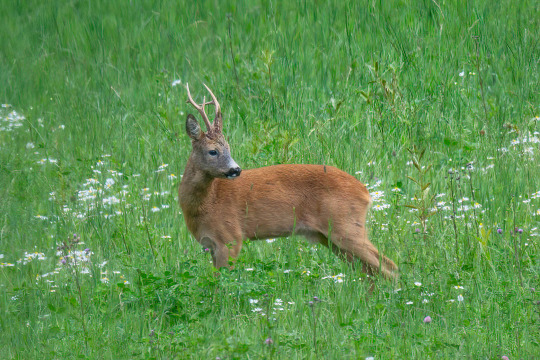
Roebuck in Vaxholm, Sweden. Photo by Bengt Nyman, 2023.
Name in English: Roe or roe deer. If you're pedantic, European or western roe deer. Name in French: Chevreuil. If you're pedantic, chevreuil d'Europe. Ambiguity warning: in Canada, chevreuil can mean the whitetail (Odocoileus virginianus). Lives in: Europe and parts of western Asia. Shoulder height: About 65 cm.
Roe deer use forests for cover, but often venture into open areas to graze. Outside mating season, they're solitary and territorial. The doe usually has two fawns rather than one, typically a male and a female.
Siberian roe deer (Capreolus pygargus)

Siberian roebuck at the Daursky Nature Reserve in Zabaykalsky Krai, Russia. Photo by Andrey Giljov, 2016.
Name in English: Siberian, eastern, or Asian roe deer. Name in French: Chevreuil de Sibérie or chevreuil d'Asie. Lives in: Take a wild guess: Asia, mainly Siberia. Shoulder height: About 85 cm.
This species is extremely similar to the closely related western roe deer, except that it's taller and thinner, and its antlers are longer. It's named pygargus after its white rump, which the western roe deer also has, so idk man.
White-tailed deer (Odocoileus virginianus)

Buck whitetail in the United States. Photo by Scott Bauer, 2001.
Name in English: Whitetail, white-tailed deer, Virginia deer (it's not particularly Virginian but ok). Name in French: If you're being pedantic, cerf de Virginie. In Québec, sometimes chevreuil. Ambiguity warning: in Europe, chevreuil means the roe deer (Capreolus sp.). Lives in: North, Central, and parts of South America. Shoulder height: Varies hugely, 0.5–1.2 m depending on subspecies.
The default North American deer. Bambi from Bambi (1942) is a whitetail.
It mostly lives at the edge of forests, often near humans. When spooked, it raises its tail, showing the white underside. This alerts other deer to danger. Litter size varies, with one, two, or three fawns.
Mule deer (Odocoileus hemionus)
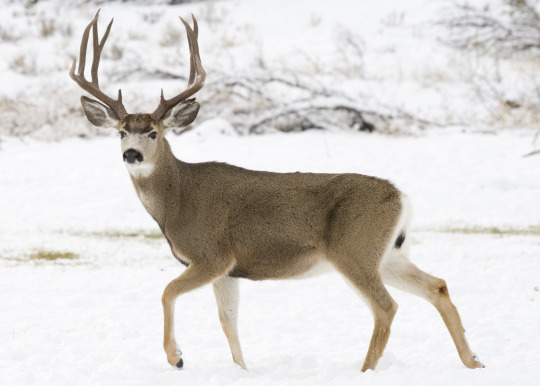
Buck mule deer in the US state of Oregon. Photo from the Oregon Department of Fish & Wildlife, 2010.
Name in English: Mule deer. Some subspecies are called black-tailed deer. Name in French: Not present in any French-speaking areas, but cerf hémione or cerf mulet. Lives in: Western half of North America. Shoulder height: 0.8–1 m
Named for its huge-ass ears. Litter size is usually two fawns, sometimes one. It's not very social and usually solitary, but can also form small groups. Infuriating fact: there's a subspecies called the Sitka deer after the city of Sitka (Alaska, USA), completely unrelated to the sika deer.
Reindeer (Rangifer tarandus)
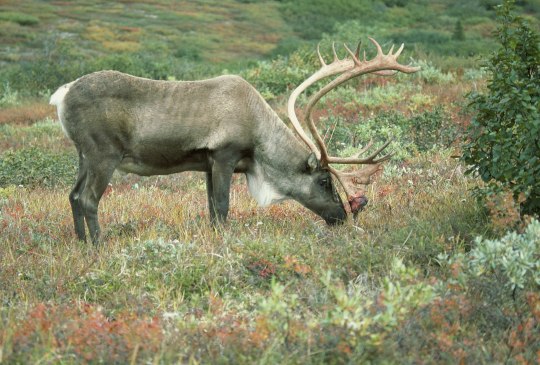
Wild bull reindeer in Alaska. Note the remains of shedding velvet on the tip of one antler. (Or don't note it, I'm not a cop.) Photo by Dave Menke, U.S. Fish and Wildlife Service, 1995.
Name in English: Reindeer or caribou. Reindeer is more common in Europe, caribou in North America. Some people use reindeer for domestic subspecies and caribou for wild ones. Name in French: Renne or caribou, with roughly the same usage patterns. Lives in: Canada, Siberia, extreme north of Europe. Shoulder height: Varies hugely by subspecies, 0.8–1.5 m.
Reindeer live in large herds. Different subspecies migrate very long distances, short distances from mountain in summer to lowlands in winter, or not at all.
They have the biggest antlers of all deer, relative to body size. Females also have antlers, which they use to compete over food during pregnancy. They lose their antlers after calving, later in the year than males.
All societies around the north pole heavily herd or hunt reindeer, and often portray them in art and culture.
Moose (Alces alces)
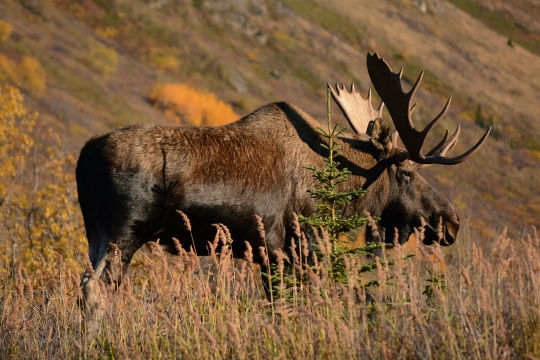
Bull moose in Alaska. Photo by Paxson Woelber, 2014.
Name in English: In Europe, elk. In North America, moose. Ambiguity warning: in North America, elk usually means wapiti (Cervus canadensis). Name in French: Exactly the same problem. In Europe, élan. In North America, orignal (you are contractually obligated to make an orignal/original pun). Ambiguity warning: in North America, élan usually means wapiti (Cervus canadensis). Lives in: All around the north pole: Canada and small parts of the northern US, northern Europe, Siberia. Shoulder height: 1.5–2 m, by far the biggest deer.
Moose are good swimmers and browse for aquatic plants. Their oddly-shaped nose gives them an excellent sense of smell, and their long legs allow them to walk through snow easily. They're mostly solitary outside mating season. They usually have one calf, but twins are very common when food is plentiful.
Siberian musk deer (Moschus moschiferus) (not a deer)
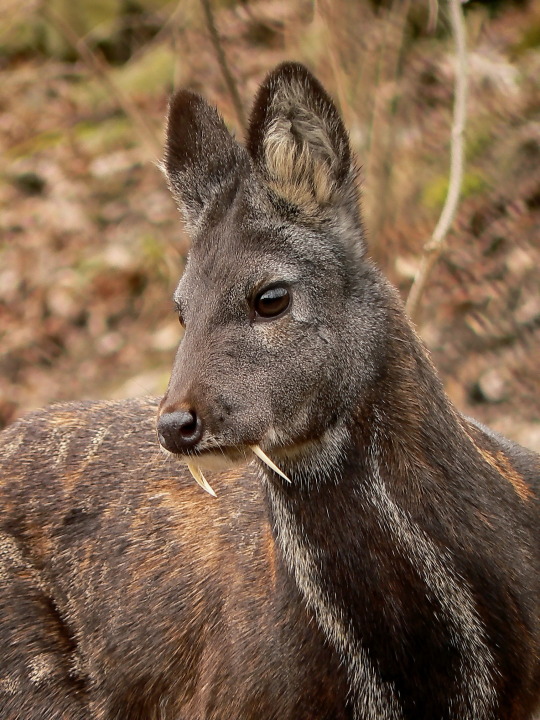
Male Siberian musk deer at a zoo in Plzeň, Czechia. Photo by Николай Усик (Nicolai Usik), 2011.
Name in English: No really common name, just Siberian musk deer. Name in French: No really common name, just porte-musc de Sibérie. Lives in: Far east Asia: Korea, eastern Siberia, Mongolia, northeastern China. Shoulder height: About 50 cm.
Musk deer are not true deer; they're more closely related to cows. There are seven species, living mostly in South Asia. None have antlers or horns, and males of all species have tusks.
Siberian musk deer are solitary and territorial. They live in sloped taiga, are nocturnal, and mainly eat lichen. Females are larger than males, for once. Litter size varies, with one, two, or three young.
Males have a gland in their schlong that makes musk, a scented substance used in perfumes and traditional medicine. They are poached for their musk and musk glands, making the species vulnerable.
Family tree of all the guys above
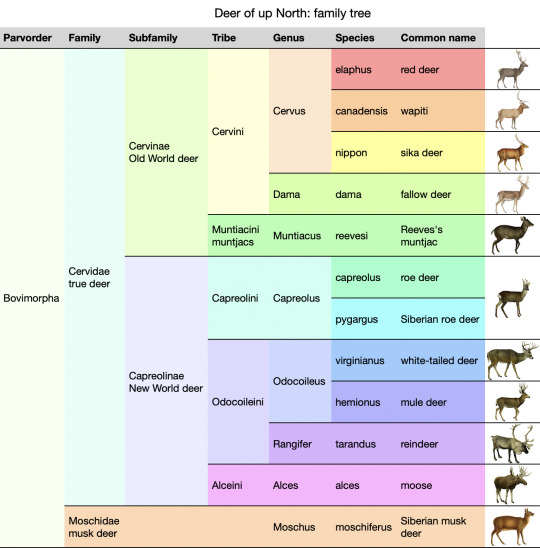
Family tree of these 12 deer. Note that the "Old World" and "New World" names for the two subfamilies are kinda fake and gay: wapiti live in the New World; roe deer live in the Old World but are the poster child of the New World family; reindeer and moose live in both.
Other cool deer include the many deer of the Indian subcontinent, like the sambar (Rusa unicolor), and the small deer of South America, like the pudu (Pudu sp). Other cool non-deer include the tiny adorable mouse-deer (chevrotains, Tragulidae).
#taxonomy#effortpost#deer#Cervidae#Ruminantia#Artiodactyla#ungulate#mammal#Mammalia#this is largely a note to self#long post cw#very long post cw
0 notes
Text
Bored and lazy so I browsed tumblr GIFs and made a kin collage :33
Warning: may cause lag!



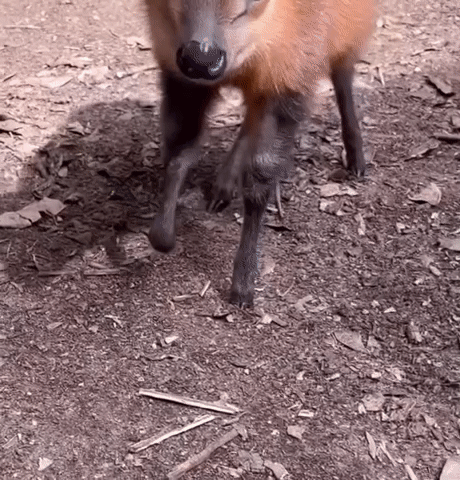

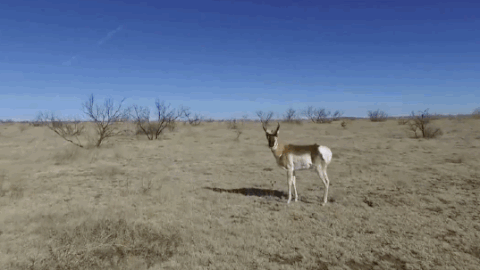
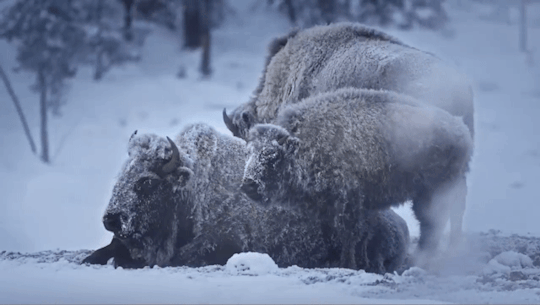

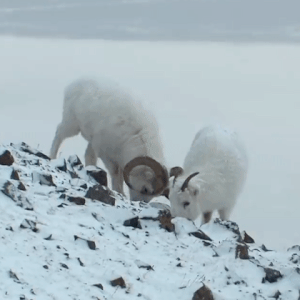

#cladotherian#ruminantia cladotherian#ruminant therian#therian#therianthropy#otherkin#alterhuman#nonhuman#therian community#alterhumanity#kin
24 notes
·
View notes
Text
Yep, that's me!!

#cladotherian#ruminantia cladotherian#bovine therian#buffalo therian#therian#therianthropy#alterhuman#otherkin#nonhuman#alterhumanity#kin#therian community
30K notes
·
View notes
Note
Gasp wait so you ruminate often
And goats are in the ruminantia suborder
So fitting!!!
Exactly... I have been doomed to ruminate for an eternity 😢😭
5 notes
·
View notes
Text
Recreación de un macho adulto de Amphimoscus en su hàbitat. Ilustración de Flavia Strani. / Universidad de Zaragoza Un equipo internacional de investigación ha realizado la primera descripción detallada del esqueleto postcraneal de Amphimoschus, un enigmático rumiante sin cuernos del Mioceno. El estudio arroja luz sobre su posición evolutiva, la evolución de los cervoideos (los parientes de los ciervos modernos) y sobre el enigma de la aparición de los apéndices craneales en los rumiantes. El estudio desvela aspectos clave sobre el enigmático Amphimoschus, un rumiante que vivió en Europa durante el Mioceno, hace entre 17,5 y 13,8 millones de años. La investigación liderada por Israel M. Sánchez, asociado al Institut Català de Paleontologia Miquel Crusafont, con la participación de personal investigador de la Universidad de Alcalá, de Zaragoza y del Museo Nacional de Ciencias Naturales ha analizado restos fósiles que permiten conocer por primera vez en 150 años el esqueleto postcraneal de este animal descrito en 1873 del que solo se tenían restos fósiles craneales y dentales. El equipo científico ha podido reconstruir la anatomía y las relaciones de parentesco de Amphimoschus gracias a fósiles inéditos encontrados en los yacimientos franceses de Artenay, Aerotrain y Thenay, prestados a los investigadores por el Museum Nationale d’Histoire Naturelle de Paris. Los resultados sugieren que este rumiante sin apéndices craneales ocupaba una posición evolutiva basal dentro del grupo de los cervoideos, es decir, los rumiantes más estrechamente cercanos a los ciervos modernos. Una especie no relacionada con los bóvidos Esta investigación desafía hipótesis previas bastante aceptadas que asociaban a Amphimoschus con los bovoideos, el grupo de rumiantes que está más emparentado con los bóvidos (antílopes, búfalos, cabras, etc.) que con los otros rumiantes. “Con los datos añadidos del esqueleto postcraneal, hemos podido confirmar que Amphimoschus no está relacionado con los bóvidos como se pensaba anteriormente, sino que es un miembro basal de los cervoideos”, explica Israel M. Sánchez. “Gracias a los análisis filogenéticos hemos logrado redibujar el árbol evolutivo de los rumiantes e identificar los tres grandes linajes a los que pertenecen los grupos actuales: Giraffomorpha, Cervidomorpha y Bovidomorpha”, añade el investigador del MNCN Juan López Cantalapiedra. Referencia: Sánchez, I. M. et al. “The postcranial skeleton of Amphimoschus Bourgeois, 1873 (Cetartiodactyla, Ruminantia, Pecora) sheds light on its phylogeny and the evolution of the clade Cervoidea”. Journal of Systematic Palaeontology. Fuente: ICP

View On WordPress
0 notes
Text
Current Strongest Kin(s): a bunch of songs
Most Preferred Name(s): Sage
Current Fronters: Sage & Cougar (probably)
Intro Post!
Hi! I'm Sage/Stolace, but you can also call me by any kin name. I'm also fine with any nicknames you can come up with, as long as they're spinoffs of my other names!
• I'm an Alterhuman, and that's what this blog will be mainly focused on, with a special focus on placekin topics.
• My pronouns are he/it/lo/🇨🇫
• I'm a minor (16+ in age)
• I am Autistic and attribute this as the source of my alterhumanity.
• I am a therian, placekin, fictionkin, conceptkin, and an alterhuman in general. Overall, I have 20+ confirmed kintypes which I'll list down below.
• I am genderfluid, and my sexuality is achillean. I identify as trans, mlm, and punkboy4punkboy. I am also objectum, especially for The Gambia and dakota discs.
• Taken by Val (he is my boyfriend /srs)
• I personally identify as a punk, degenerate, freak, and social reject. I reclaim these terms proudly.
• Liminous (Dreadliminal, Backroomian, +more)
• I am the functioner of an Imagian plurality. Collectively, we use they/them pronouns. We are mixed-origin and pro-endo, but we aren't really concerned about our own origin or if we are disordered or not.
[ Kinlist, Identities, Tags, and BYF under the cut. ]
♡ -> Kinlist <- ♡
• Theriotypes:
♡ Lipizzan
♡ Fisher
♡ Quoll (Species leaning: Eastern & Spot-Tailed)
♡ Ruminantia (Cladotherian)
♡ Ardeidae (Pluritherian)
♡ New Guinea Singing Dog / Canine
♡ Big Cat (Lion / Cougar)
♡ [Unsure] Kori Bustard
• Placekin:
♡ Central African Republic (C.A.R. / CAR)
• Conceptkin:
♡ Home Safety Hotline/HSH
*[as in the company, not the physical game]
♡ Slaughterhouse (GD level)
♡ Limbo (GD level)
• Songkins:
♡ Can't Stop - Red Hot Chili Peppers
♡ Everyone Knows That/EKT (Lostwave version)
♡ B O D Y O N T H E F L O O R - Scratchy
♡ you don't love me - Rebzyyx
• Songflickers:
[ Currently None ]
• Fictionkins:
♡ Stolace* (Helluva Boss)
♡ Vox (Hazbin Hotel)
♡ Adam (Hazbin Hotel)
♡ Stone (Ramshackle)
♡ Moisty (TWISTED DOCTOR Universe / Doll Eye)
♡ Nabbit (Mario Franchise)
♡ Cooper (Papa's -eria games)
♡ 1st Prize (BBIEAL)
♡ Blabbot (Amanda the Adventurer)
*[ I spell my name as "Stolace", not "Stolas". ]
• Fictionhearted:
♡ Blitzø (Helluva Boss)
♡ Valentino (Hazbin Hotel)
• Other Hearttypes:
♡ D.R.C.
♡ Birds
♡ Bat-Eared Fox
• Other Identities:
♡ Myotis/Little Brown Bat w/ Leafnose
♡ Common Bedbug copinglink
♡ Seagull copinglink
♡ Odie copinglink (from Garfield)
Special Tags:
#I am the CAR kin / #CARstuff🇨🇫: Posts about my placekin experience as the Central African Republic.
#placekin questions: Answering questions about Placekin and my experience with being placekin.
#🇨🇫❤🇬🇲: Posts about my objectum crush, The Gambia
#aWannabe: Posts about my favorite music artist, aWannabe.
Before You Follow (BYF) :
• I am a minor (16+)
• I don't mind if 18+ blogs interact in a SFW manner, as long as your blog isn't entirely/mostly NSFW
• I like Hazbin Hotel and 4-5 of my headmates are sourced there (some ppl have this on their DNI???)
• I'm dating Valentino from Hazbin Hotel. /srs
• I am against gatekeeping and exclusion.
• I welcome and support every kind of system, plurality, and multiplicity, including endos. I am part of a mixed-origin imagian plurality myself.
• I welcome and support factkin and factives. I am not one myself, but our plurality does have factives.
• I do not post or repost anything political on this blog, unless it is in reference to placekin.
• I don't participate in proship or radqueer discourse on this blog. Consider me neutral.
• I have no DNI. I cannot stop you from making that first interaction with me. If I strongly disagree with your views or you make me uncomfortable, I will just block you.
#intro post#blog intro#introduction#alterhuman#therian#otherkin#fictionkin#placekin#nonhuman#kin#therianthropy#moistykin#CARkin#I am the CAR kin#C.A.R.kin#countrykin#place kin#locationkin#location kin#imagian#therian punk
39 notes
·
View notes
Note
THIS!!!!
This is so ME!!
I'm a horse and a Ruminantia cladotherian, and I used to do this ALL the time.
I'm so tired of people seeing me as socially unacceptable for being who I am :')
Elk therian culture is trying to express emotions by flicking your ears back and snorting at people and then realizing that’s not socially acceptable
.
#therian#therian culture#therian culture is#alterhuman#therianthropy#elk therian#horse therian#cladotherian#ruminantia cladotherian
85 notes
·
View notes
Text
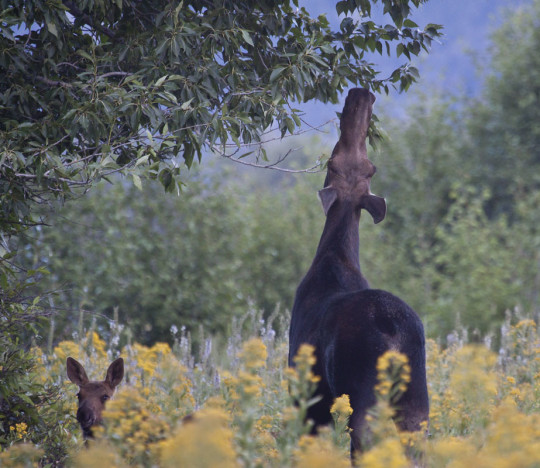
Shiras moose (Alces alces shirasi)
Photo by Marlin Harms
#shiras moose#moose#alces alces shirasi#alces alces#alces#alceini#capreolinae#cervidae#ruminantia#pecora#cetruminantia#artiofabula#artiodactyla#euungulata#laurasiatheria#boreoeutheria#eutheria#scrotifera#mammalia#tetrapoda#chordata
516 notes
·
View notes
Text
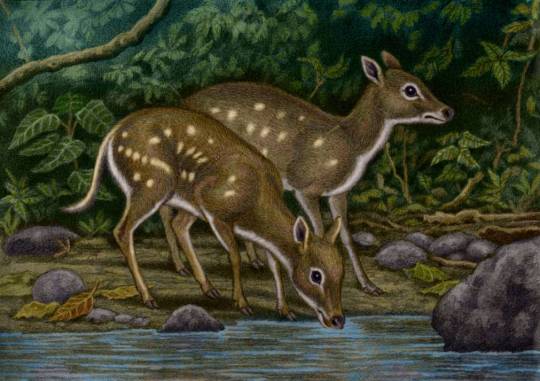
Leptomeryx
Leptomeryx — вимерлий рід парнокопитних ссавців із родини лептомерицидів (Leptomerycidae) підряду жуйних (Ruminantia), які жили з середини еоцену до початку міоцену на території Північної Америки.
Повний текст на сайті "Вимерлий світ":
https://extinctworld.in.ua/leptomeryx/
#leptomeryx#leptomerycidae#ruminantia#mammal#eocene#north america#artiodactyla#miocene#paleontology#paleoart#prehistoric#animals#палеоарт#палеонтологія#ukraine#ukrainian#prehistory#science#extinct#illustration#art#українська мова#мова#україна#арт#ua#animal art#fossils#daily#uaart
6 notes
·
View notes
Photo
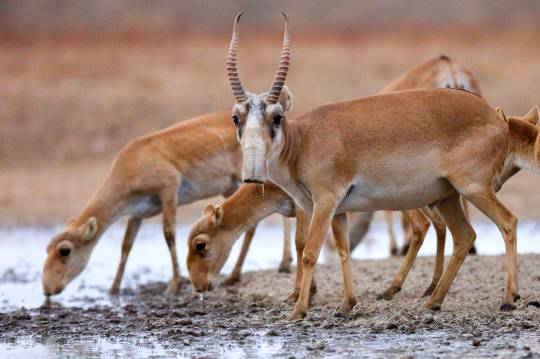
Saiga antelopes at the Stepnoi nature reserve in Liman district of Russia’s Astrakhan region. The site was created in 2000 especially for saiga antelopes
Photograph: Dmitry Rogulin/TASS/Getty Images
(via The week in wildlife – in pictures | Environment | The Guardian)
#Saiga tatarica#Saiga#Antilopini#Antilopinae#Bovidae#Ruminantia#Artiodactyla#Mammalia#mammal#antelope#endangered#Russia
41 notes
·
View notes
Photo

Island Weirdness #14 -- Hoplitomeryx
During the mid-Miocene, about 15 million years ago, a region of central and southeast Italy around Gargano and Scontrone was cut off from the mainland by rising sea levels.
For the next 7-10 million years this island (or perhaps a cluster of islands) was left isolated, and an unusual ecosystem developed known as the “Mikrotia fauna”. With the island starting off lacking large predators, small herbivorous animals like rodents, pikas, and waterfowl became huge -- and then small predators like gymnures and carnivorous birds also grew to keep up with the increasing size of their prey.
One of the strangest residents of the island(s) was Hoplitomeryx, an early type of ruminant that resembled a deer or pronghorn. Nicknamed the “prongdeer”, it had a total of five horns on its head and large protruding fangs similar to some modern deer.
Multiple species of Hoplitomeryx have been identified, representing four different size classes ranging from huge down to tiny insular dwarfs. The largest is estimated to have been similarly sized to modern moose, standing around 2m tall at the shoulder (6′6″), while the smallest would have been under 50cm (1′8″).
Each of these size classes was specialized for slightly different ecological niches, eating different types of vegetation to avoid directly competing with each other for the limited amount of food on the island.
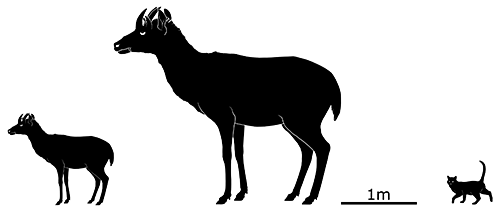
#island weirdness 2019#science illustration#paleontology#paleoart#palaeoblr#hoplitomeryx#hoplitomerycidae#ruminantia#artiodactyla#ungulate#mammal#art#prongdeer#pentacorn#gargano-scontrone island#island weirdness part 1
203 notes
·
View notes
Photo
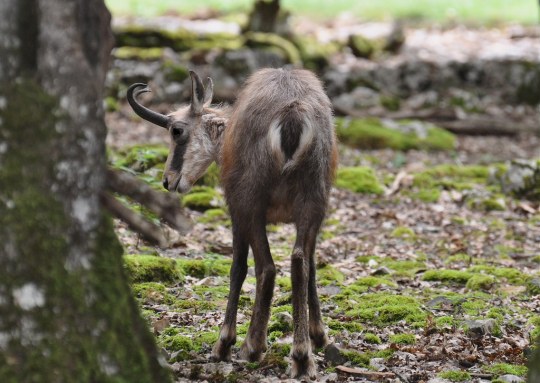
Rupicapra rupicapra - Chamois - 25/06/16 by Philippe_Boissel Rupicapra rupicapra - Chamois fr.wikipedia.org/wiki/Chamois#/media/File:Rupicapra_rupic... https://flic.kr/p/2iRb6Jz
1 note
·
View note
Text
Smallest...

and Largest!

therians, if you have multiple theriotypes; what is your smallest one and ur largest one??
i'll go first ! ! my smallest . . . . . . . . . . . . . . . . . . . . . . . . my largest


harvest mouse. . . . . . . . . . . . . . . . . . . leucistic lion
#therian#cladotherian#ruminantia cladotherian#placekin#CARstuff🇨🇫#otherkin#alterhuman#alterhumanity#therianthropy#kin
452 notes
·
View notes
Text
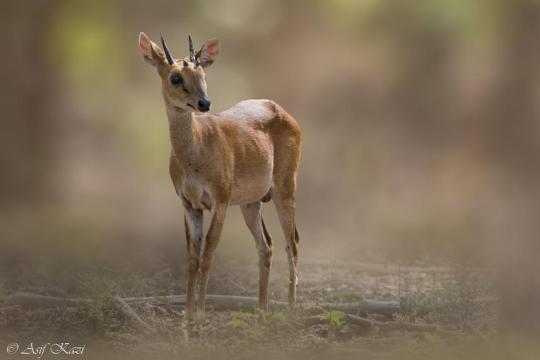
Four-horned antelope (Tetracerus quadricornis)
Photo by Asif Kazi
#four horned antelope#chousingha#tetracerus quadricornis#tetracerus#boselaphini#bovinae#bovidae#ruminantia#artiodactyla#laurasiatheria#placentalia#mammalia#tetrapoda#vertebrata#chordata
117 notes
·
View notes
Text
i know i talk about this every goddamn day but i could start crying !!!!!!!!!!
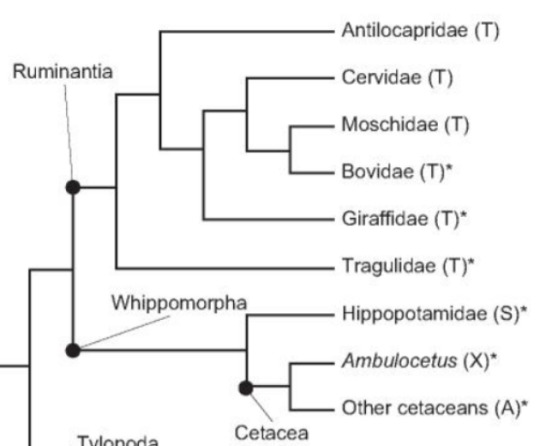
#the closest relative after hippopotamidae is ruminantia#RUMINANTS! like deer cows sheep#the fact whippomorpha is literally just the english whale and hippo combined is kind of horrifically funny
11 notes
·
View notes